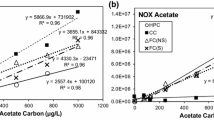Abstract.
Cryptosporidium parvum oocyst viability was determined by a dye permeability assay using a flow cytometric method. Oocysts were inoculated into small chambers with soil and biosolids. Oocysts extracted from soil and biosolids were then stained with propidium iodide (PI) and labeled with a fluorescein isothiocyanate (FITC)-conjugated monoclonal antibody. The oocyst population in each sample was determined using forward and side scatter plots, then further analyzed with fluorescence. A red and green fluorescence detector using gates established single populations of unstained, PI-stained, or FITC-labeled oocysts. No statistical difference was observed between viability of oocysts extracted from soil and biosolids as determined by either flow cytometry or microscopy. The location of excysted oocysts was changed in forward and side scatter plots. Results indicated that, although oocysts are not identified if they excyst, the flow cytometric method could be used to determine oocyst viability from spiked environmental samples.
Similar content being viewed by others
Author information
Authors and Affiliations
Additional information
Electronic Publication
Rights and permissions
About this article
Cite this article
Kato, S., Bowman, D.D. Using flow cytometry to determine the viability of Cryptosporidium parvum oocysts extracted from spiked environmental samples in chambers. Parasitol Res 88, 326–331 (2002). https://doi.org/10.1007/s004360100504
Received:
Accepted:
Published:
Issue Date:
DOI: https://doi.org/10.1007/s004360100504




